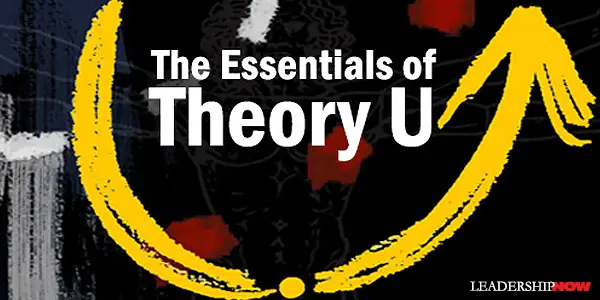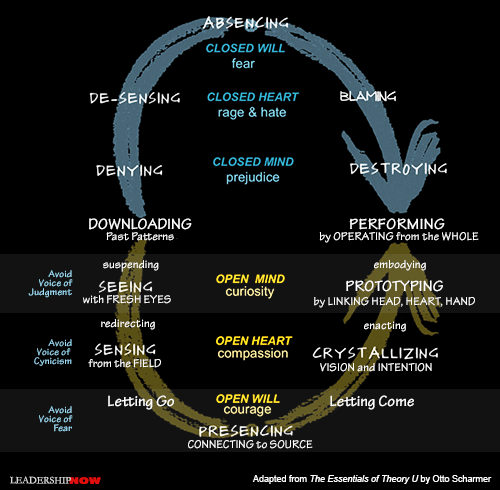 |
 |
04.05.18

The Essentials of Theory U
W Part of the problem is the way we approach what we “know” and do. We need a new way of seeing, learning, and doing. This is what Otto Scharmer hopes to do with Theory U. With Theory U, Otto Scharmer has taken well-known ideas and combined them in a profound way. He asks, “How do we learn from the future as it emerges?” In The Essentials of Theory U, Scharmer takes the ideas first presented in Theory U over ten years ago, and made them more accessible. Theory U begins with our blind spot. We see the world the way we are. We create the world we live in. Action comes into the world from what is going on inside of us. Scharmer says, “I pay attention this way, therefore it emerges that way.” So we begin to understand Theory U with the blind spot. Too often we don’t factor in our interior condition. “We can see what we do (results). We can see how we do it (process). But we usually are not aware of the who: the inner place or source from which we operate.” That is our blind spot: the place from which our attention and our intentions originate—our source. The question for leaders is “How does our blind spot show up in our leadership?” What I give attention to, what I notice, what I act on, is a function of my interior condition. This of course, affects how and what we learn and thus what we can apply to any given situation. Typically, we learn from the experiences of the past, but because or most issues, responding with what we have learned is not going to be enough, Scharmer suggests that we work to learn from the future as it emerges. He calls this presencing. We can engage in the moment in two ways. One is the present moment that “is basically and extension of the past. The present moment is shaped by what has been. The second is a quality of the present moment that functions as a gateway to a field of future possibilities. The present moment is shaped by what is wanting to emerge. That quality of time, if connected to, operates from [pre-sensing] the highest future potential.” In times like ours, it is this second presencing quality of the present that matters most because “without that connection we tend to end up as victims rather than co-shapers of disruption.” How can we begin to presence as individuals, organizations, and as a society? Theory U is a way of making a system (or an individual) sense and see itself. The core process can be seen in the diagram below. Looking at the bottom “U” Scharmer describes each of the seven ways of attending to and co-shaping the world: Downloading is business as usual. Repeating the same old patterns of thought. In this state, “the world is frozen by our old mental habits and past experiences; nothing new enters our minds. Seeing is when we suspend our habitual judgment and wake up with fresh eyes. As we suspend we have to tolerate that nothing is happening. Staying with it is the key. Sensing is the “moment we redirect our attention from objects to source.” Our perceptions widen and deepen. “The boundary between observer and observed opens up.” We begin to see the from a perspective that includes ourselves. The system begins to see itself. Presencing is when we let go of the old and connect to the surrounding sphere of future potential. “The boundary between observer and observed collapses into a space for the future to emerge.” We are connecting to the deepest source—the interior condition from which we operate. Our purpose. Seeing from the whole. We must be willing to drop everything that is not essential. “Crossing the threshold means to be willing to let go. TO let go of old patterns, assumptions, and even our old ‘ego-self.’ Only then is it possible to step into our dormant potential, our emerging ‘Self.’” Crystallizing is when we begin to envision the future that seeks to emerge from a deep connection to the source. “Envisioning happens from the field of the future (rather than from our ego). Prototyping is exploring the future by doing. Bringing the new into reality by improvising and linking the intelligence of the head, heart, and hands. Performing by embodying the new from the context of the larger eco-system—the whole. Embedding the new through new practices, processes, and infrastructures while maintaining a connection to the source. The inverted view on the top of the chart is about destruction rather than creation. It is the result of closed will, heart and mind—fear, hate, and prejudice. Rather than experiencing presencing after downloading, we begin to deny or silence other views out of prejudice, we entrench, manipulate, bully and eventually destroy. Scharmer says “leadership is the capacity to shift the inner place from which we operate.” So that the primary job of leadership is to help people discover the power of seeing and seeing together. Theory U is about change. When you as a change maker begin to see what you didn’t see before and at the same time, see your own part in maintaining and defending to past patterns and thinking, real change can begin to occur. “The key leverage point for transformational change starts with attending to how you as a change maker relate to the system that you want to change and to the system that you want to give birth to.” For Scharmer, understanding change, boils down to this: “The quality of results achieved by any system is a function of the quality of awareness that people in these systems operate from. In three words: Form follows consciousness.”  
Posted by Michael McKinney at 07:39 AM
|
BUILD YOUR KNOWLEDGE
 

How to Do Your Start-Up Right STRAIGHT TALK FOR START-UPS 
Grow Your Leadership Skills NEW AND UPCOMING LEADERSHIP BOOKS 
Leadership Minute BITE-SIZE CONCEPTS YOU CAN CHEW ON 
Classic Leadership Books BOOKS TO READ BEFORE YOU LEAD |